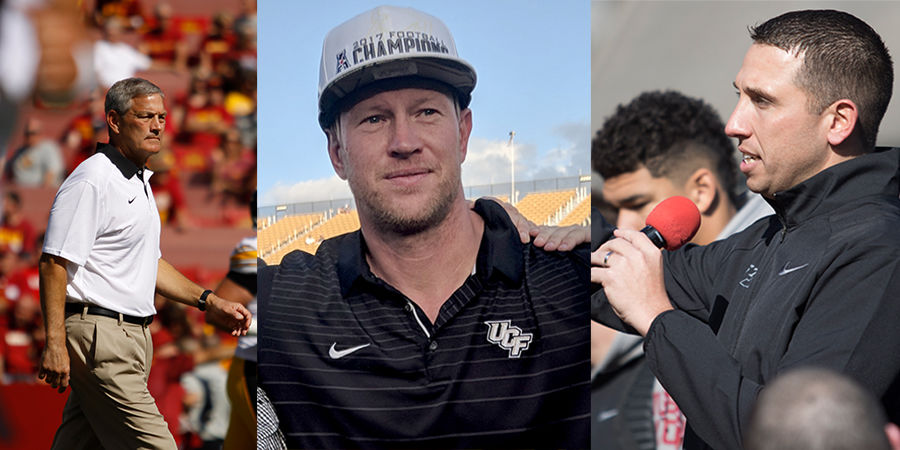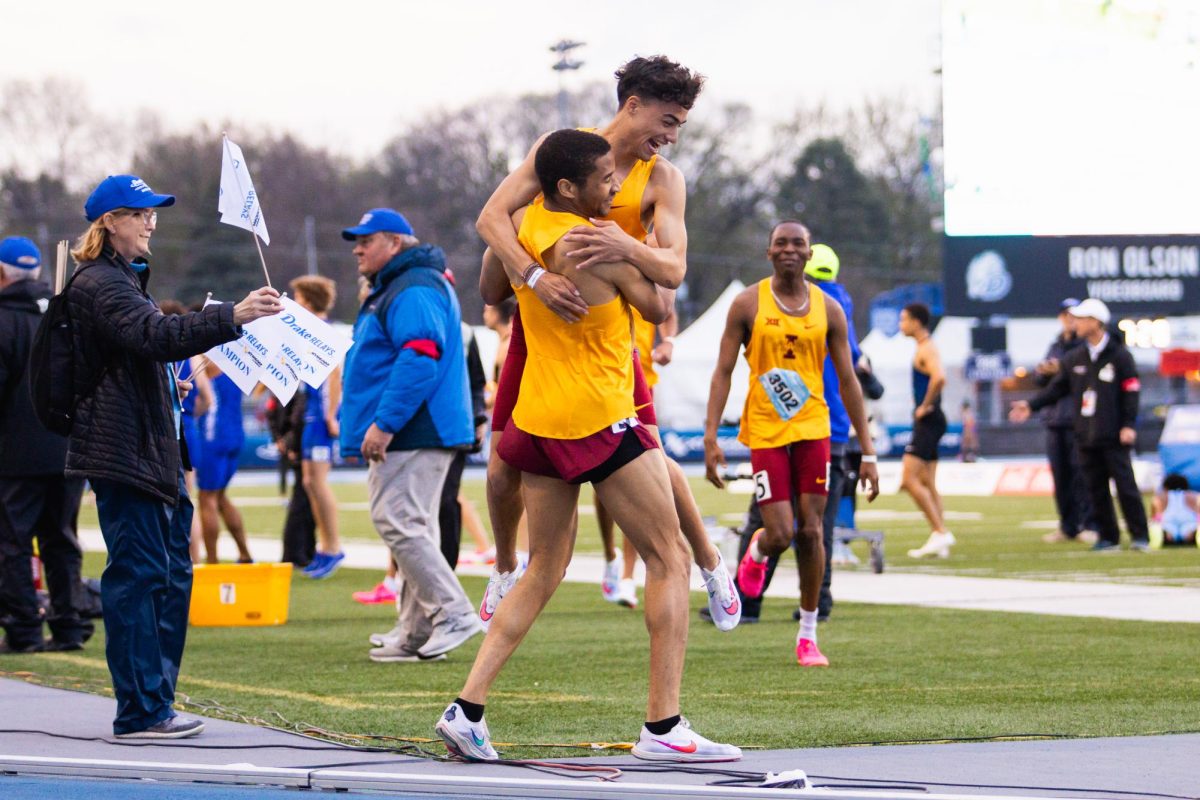Stunted growth: Examining diversity in college football and basketball
April 8, 2018
Editor’s Note: This is the first part in a three-part series about the diversity of coaches in the high school and collegiate ranks.
Look at the roster of any major college football or basketball team. Look at the Iowa Hawkeyes, Iowa State Cyclones or Nebraska Cornhuskers’ sideline on a fall Saturday.
There are players of all different races and backgrounds, banding together to become a team and sharing a common goal.
Take a look at the head coach. The most powerful man in the entire athletics program, apart from the athletic director. At times, the face of the university. Look back into history as far as you can, all the way until the head coaches don’t even get a stock photo in their bio page.
Notice something similar between all three of those schools?
The head football coach is white.
As of March 2018, not one of these three schools has ever employed a minority as their head football coach.
With the addition of Liberty University, there are now 130 programs at the Football Bowl Subdivision (FBS) level in Division I college football. That, of course, means there are 130 head coaches. But only 13 of them are African-American, and only 17 total head coaches are people of color.
Percentage-wise, that’s a paltry 13 percent of coaches at the FBS level who are of color.
At the FBS level in 2016-17, 63.4 percent of all participating football players were people of color.
How is it possible, then, that there are so few minority coaches, considering most coaches in the profession are former players?
Assistant coaching staffs are generally more diverse, especially in college basketball. Iowa State’s current basketball coaching staff, led by Steve Prohm, has four African-American coaches on staff. However, even in basketball (where a whopping 74.9 percent of all Division I men’s athletic participants were of color), the road from assistant to head coach is often more difficult for coaches of color.
****
Iowa State has only had one head coach of color in the two major sports, the short-lived tenure of Wayne Morgan, an assistant of former head basketball coach Larry Eustachy. Morgan, who was named head coach after Eustachy’s unceremonious firing, was fired after only three seasons at the helm. ESPN reported he was shocked by the decision, as he had finished his third season with a 55-39 overall record. He played a big role in getting Iowa State all-timers such as Will Blalock and Curtis Stinson to the Cyclones, and he had won an NCAA Tournament game just a year before he was let go.
Although, it should be mentioned Morgan’s tenure was marred by a report from CBS SportsLine which alleged Iowa State to be in the middle of a recruiting scam involving non-conference “guarantee” games.
Morgan was replaced by then-Northern Iowa coach Greg McDermott, who went on to have a worse record (59-68) in four years at the helm before bolting for Creighton in 2010.
Iowa State athletic director Jamie Pollard was unable to be interviewed for this story due to being out of the office for multiple weeks.
There are challenges head coaches of color face at the collegiate level. It’s no wonder, in the most recent NCAA Gender and Diversity Report Card from Dr. Richard Lapchick of the University of Central Florida, college sports earned a C-plus grade in racial hiring practices, nearly a full letter grade down from the 2015 report of a B grade.
According to the report, college sports was the only area covered by the report that didn’t receive a grade of at least a B.
In the two major college athletic conferences that cover Iowa and the Midwest, the lack of coaches of color is especially noticeable. Only two head coaches in the Big 12 Conference are of color, second-year Texas basketball coach Shaka Smart and Oklahoma State’s first-year basketball coach Mike Boynton. It’s been since 1993-94 that the conference has not had a basketball coach of color, but only twice has the league had four coaches of color in a single season (most recently in 2003-04).
For comparison’s sake, this year in the SEC there were four minority basketball coaches. Since 2003-04, there have been 11 seasons in which the SEC has had four or more minority head coaches.
The Big 12 is lacking on the football side of things as well. With the departure of Charlie Strong and hiring of Tom Herman from Houston, the Big 12 was left without a minority head football coach in its ranks.
In fact, the conference’s last African-American head coach before Strong was the ill-fated tenure of Turner Gill at Kansas from 2010-2011. That hasn’t necessarily been an uncommon occurrence across the country, though.
The Big 10 also only has two head coaches of color in its football and basketball ranks in Illinois football coach Lovie Smith and Penn State coach James Franklin, after the 2016 firing of Darrell Hazell. A Minneapolis Star Tribune article from 2017 details the decline of head coaches of color in Big 10 basketball, a league that in 1997 was the most diverse power conference in the country.
Iowa has not hired a minority coach in either football or basketball since the tenure of George Raveling. Raveling went 55-38 in three seasons with the Hawkeyes, taking them to two straight NCAA Tournament berths in 1985 and 1986. He bolted to USC months later (and became the Trojans’ first African-American basketball coach in the process), and Iowa reached out to Tom Davis. The rest, as they say, is history.
****
The 2017-18 season marks the second straight without a minority head coach in Big 10 basketball, after the 2016 dismissal of Eddie Jordan by Rutgers. The Star Tribune article states, after having a coach of color in each and every season from 1983 to 2014, Jordan is the only minority basketball coach the Big 10 has had since the firing of Tubby Smith from Minnesota in 2013.
High-level athletic departments that have yet to hire a minority head coach for either of the two major college sports include Nebraska, North Carolina, Duke and Michigan State.
Nebraska, the school among the four that made the most recent coaching hire, was rumored to have been interested in Virginia Tech head coach Justin Fuente, but instead hired Nebraska native Scott Frost (though, to his credit, Frost’s Nebraska staff is one of the most diverse in school history, with five of the 10 allowed on-field assistants being African-American).
All that being said, it’s clear the Big 10 has taken a drastic step back in terms of diversity, and the Big 12 is not necessarily picking up the slack. Kansas and Nebraska are the only two Big 12 programs over the last 38 years (yes, this includes Nebraska, even though they left for the Big 10 in 2011) have not had a basketball coach of color. The same can be said for new Big 12 members West Virginia. In the Big 10, Purdue, Michigan State and Illinois share this distinction.
But the Midwest’s issue with hiring diverse head coaches isn’t just a regional issue.
This is a nationwide problem.
SB Nation’s Richard Johnson spent a lot of his article from 2017 on this problem talking about the problems this coded language causes as it pertains to coaches of color moving up in the coaching ranks. Johnson found in the Power Five conferences, only three out of 65 quarterback coaches were African-American.
Johnson said in a phone interview part of the problem is the categorization of many African-American football coaches as “recruiters.” This is an example of coded language (using terms such as “recruiter” and putting minority coaches in more marginal positions, such as running back coach and defensive back coaches) that pigeon-holes many assistant coaches of color and can keep many from even stepping foot in the profession, much less becoming coordinators or head coaches.
Johnson said this language creates a culture of “cascading plausible deniability.”
He also mentioned a big issue was the pushing of many athletes of color in high school from quarterback to other positions (mainly wide receiver and running back).
“A majority of offensive coordinators are quarterback coaches, and a majority of quarterback coaches played quarterback in college,” Johnson said in a phone interview. “If you’re getting pushed away from that position before you even get to college, it’s going to be really hard to rise in the coaching ranks.”
The amount of assistant coaches, while higher than head coaches, was still only 26 percent in 2015, according to CBS Sports.
But what about all of the schools that HAVE hired coaches of color recently? Why are there so few coaches of color in college football, with the rise in hires of candidates of color in the 21st century?
The main problem is, if a coaching hire of color does not work out, that program is very unlikely to replace the departing coach with another candidate of color, as this report from FootballScoop said. That trend was reversed slightly in the 2017 off-season, as two schools replaced a coach of color with another — Oregon with Mario Cristobal and Arizona with Kevin Sumlin. Recently, though, these examples are far closer to an exception than to the rule.
Nationwide, the opportunities for coaches of color in college basketball are declining as well. Lapchick’s Diversity Report Card notes in 2015-16, “20.2 percent of all head coaches were African-American … It is down 4.4 percent from the all-time high of 25.2 percent in 2005-06.”
It’s clear the hiring of coaches of color in every single power conference has been slowing down in college basketball, and college football’s commitment to growing diversity among coaches hasn’t gone according to plan.
As stuck as college athletics may seem, they have pushed miles ahead of Iowa high schools.
















